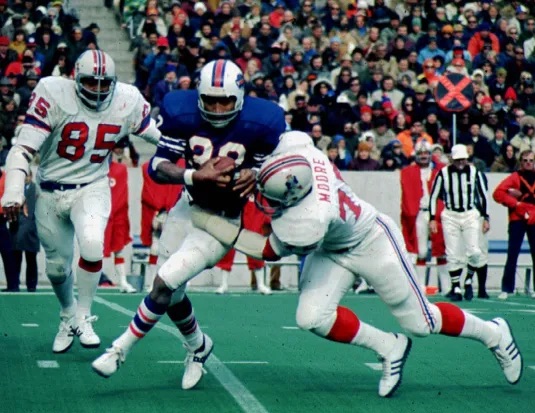By Sun Senior Sports Columnist CHUCK POLLOCK
He was the most charismatic athlete I ever interviewed … and that includes Jerry Rice, Joe Namath, Mickey Mantle, Pete Rose, Gordie Howe, Wayne Gretzky, Bill Russell and Michael Jordan.
There was an electricity about O.J. Simpson that superseded even the most high-profile, media-friendly pros.
He died Wednesday, at age 76 in Las Vegas, due to complications from prostate cancer. His legacy having regressed from one of the greatest running backs in NFL history to a national pariah who somehow escaped guilt in a grisly double murder.

My experience with “Juice,” as he came to be nicknamed rather than the initials which stood for Orenthal James, was mere good fortune.
IN JANUARY of 1973 I was hired by the Olean Times Herald to cover the Bills, NBA Buffalo Braves and write columns on them and St. Bonaventure basketball.
I met Simpson at training camp that year, held at Niagara University, which didn’t even have a football team, necessitating goalposts that were wheeled out onto the field.
O.J., back then, was seen as an enigma since his first two seasons, he was used as a “decoy” by coaches John Rauch and Harvey Johnson. It was a curious choice as the Bills didn’t have any offensive weapons worthy of a “decoy.”
But, in 1972, Lou Saban was rehired as head coach and, knowing a game-changer when he saw one, installed O.J. as Buffalo’s feature back.
He responded with 1,251 rushing yards and six TDs including a 94-yarder. At 6-foot-2, 212 pounds with sprinter’s speed that was just a tease for ‘73.
Saban revamped the offensive line, installing Mike Montler, a tough former Marine who played at Colorado, at center, Reggie McKenzie, a second-year pro from Michigan taken in Round 2, at left guard and rookie Joe DeLamielleure, a first-round choice from Michigan State, on the right.
At tackle were Dave Foley, picked up on waivers from the Jets, on the left, and Donnie Green, 6-foot-8, 272, huge for those days, on the right. The tight end, in name only, was rookie Paul Seymour, the Bills’ second first-rounder that year, and he, in effect, was a third tackle.
Those six became collectively known as “The Electric Company,” which “Turned The Juice Loose.”
IN ‘73’s training camp, I was amazed at the total access. When practice ended we — four or five writers and three TV sportscasters — went out on the field and talked with whoever we wanted. No press conferences, no logoed backdrops … if you wanted Saban one-on-one, have at it, O.J. Simpson, he’s over there.
Back then, the media traveled with the team … on the charter and the bus.
Buffalo’s season opener was against the Patriots in Schaefer Stadium, a poorly-appointed three-year-old dump in Foxborough, Mass.
By coincidence, I was on the same bus as O.J. and followed him and a number of players onto the chintzy synthetic surface. Simpson took a quarter, flipped it, and was shocked that it bounced back almost to hip level. He quickly assessed “That’s some hard sh*t.”
It didn’t bother him when the game started, though. Juice rushed for a then-NFL record 250 yards, his first of three 200 yards games that season. That included the season finale in the snow at Shea Stadium against the Jets in which he not only surpassed Jim Brown’s single-year mark of 1,863 rushing yards, but finished with an amazing 2003.
In 14 games that year, Simpson not only set NFL records for rushing yards in a season, he also produced league standards in rushing attempts (332) and single game rushes (39), most games of 100 yards or more (11) and most consecutive such games (7).
In the postgame press conference, O.J. brought his entire offensive line into the crowded interview area and before any questions said, “I want you to meet some friends of mine.”
It was a rare show of humility in a league saturated with ultra egos.
THAT WAS the season O.J. became “Juice.”
Every postgame interview session became an event with Simpson handling the national media with poise and personality. But what stood out was that he had as much time for a reporter from a 500-watt radio station in Batavia as he did for the big-name sportscasters. Simpson found time for everybody in the press np matter the outlet.
One time, when being interviewed postgame, a film crew was doing a documentary about him and he was giving instructions to the camera and sound people while simultaneously answering questions.
He was a larger-than-life figure in a smaller city such as Buffalo, especially as he became such a national celebrity. And the proof was, in a near-unprecedented move, Hertz hired a Black man to become its lead national spokesperson.
His squeaky-clean image wasn’t marred by a reputation for womanizing as a married man … his people skills bought him a pass.
Visiting media were amazed at his ability to do a semi-eloquent interview — he never learned “hisself” wasn’t a word — then head over to the so-called “The Ghetto” area where the defensive backs dressed and converse with them in street language.
His celebrity spawned a movie career and after nine years in Buffalo, he spent the two final seasons in the Bay Area, his home, via one of the worst trades in NFL history.
The late Joe Thomas, then general manager for the 49ers, sent a first-round draft choice, two seconds, a third and a fourth for a 31-year-old Simpson who, by then, was used up.
In two seasons with San Francisco, O.J. totaled 1,053 rushing yards, four rushing scores and two receiving TDs.
It was clear to many that he was “mailing it in,” quickly leaving practices to jump into a red, convertible sports car with a stunning blond named Nicole Brown.
The two later married and in June of 1994 Brown-Simpson and her friend Ron Goldman were viciously stabbed to death in the Brentwood neighborhood of Los Angeles.
Five days later O.J. was arrested amidst reports he had physically abused Nicole in the past.
A 9-month “Trial of the Century” captivated the country on daily TV and I watched a lot of it fearing an unexpected outcome. In the end, a predominately Black jury, in four hours, found him “not guilty” … not innocent.
But the bulk of America felt he was unquestionably guilty.
IN 1984, as part of his two-year stint on the Monday Night Football crew, O.J. was in Buffalo for the broadcast and a friend of mine from a Western New York newspaper interviewed him.
He had never dealt with Simpson during his playing career, but O.J. was still his usual gracious, accommodating self.
“O.J. Simpson,” my awed friend said, “ is one of the nicest human beings I’ve ever met … almost too good to be true.”
And while I’m not prescient, I pointed out, “Sometimes, no matter how charming they might appear, they aren’t always what they seem.”
Little did I know.
(Chuck Pollock, a Wellsville Sun senior sports columnist, can be reached at cpollock@wnynet.net.)
Read more from Chuck:
- When do we hear from Schmidt?
- • Barb Questa to the rescue once again for St. Bonaventure with the AD situation
- • Bona’s Manhertz’s self-inflicted NIT embarrassment ended his tenure
- • St. Bonaventure made every excuse to skip the NIT except the eclipse
- • A look at the current Bona player situation and how it relates to the past
- • The Buffalo Bills have had darker days with cuts during off-season
- • Caitlin Clark brings up memories of St. Bonaventure women and men’s basketball players
- • St. Bonaventure primed for strong finish in Atlantic 10
- • Feature on the Bonnies as the season winds down
- • What to make from the Super Bowl
- • A look at free agency with the Buffalo Bills
- • Don’t blame Bass for the playoff loss
- • St. Bonaventure coach Mark Schmidt was right about the Atlantic 10 and the Bonnies
- Why the Bills and Steelers might be the best wild-card game this weekend
- • Bills claim the No. 2 seed
- • Pollock predicts a 35-30 Dolphins victory
- • It’s 2024 and the Bonnies season starts for real
- • The inside story on why WPIG left the Bonnies after 74 years and a Gary Nease update
- • Bonnies look sharp in tune up to season
- • Pollock’s playoff picture
- • It wasn’t pretty, but it was a win for the Bills
- • The Bills need a win, not a blowout
- • McDermott deserves praise after win vs. the Dallas Cowboys
- • On this day, the Bills manhandled the Cowboys
- • The Bills win at KC turned the heat down on McDermott and Miller
- • At last, another teams gaffe helps the Bills win
- • The Bills must beat the Chiefs and distractions
- • Who is this Ty Dunne?
- • Why Chuck Pollock returned to writing and covering the Bills after a two-week “retirement”
- • Flags? Taking a knee before the half? Buffalo Bills’ apologists are whining in the wrong place
- • Was Dorsey the latest sacrificial lamb?
- • POLLOCK PREDICTION: McDermott will fire Dorsey next
- (You can support the work of our journalists and keep this site free with a PayPal donation HERE)
- • Awkward press conference for the Bills and McDermott
- • If season ended today, the Bills are out of the playoffs
- • Are the Bills a playoff team?
- • Bills produce a third straight stinker
- • An ugly win for the Buffalo Bills
- • The AFC is wide open with Buffalo injuries
- • Injuries were worse than a loss in London
- • Bills prepare for Jacksonville
- • The passing of Russ Francis and what it was like covering the Bills in the 1970’s
- • News and notes from a costly win by the Bills over Miami
- • A look a high school, college and NFL blowouts
- • Did the Bills find a middle linebacker in win vs. Washington?
- • Pollock Predicts: Take the Bills over Washington



